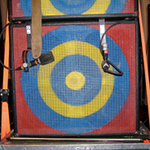Charles Lutz
Ends and Means
C24 Gallery
514 West 24th Street, New York, NY
January 17–March 1, 2013
The jaw-dropping prices many contemporary artists command at auction induce a profound anxiety over art and aesthetics, especially since figures such as Jeff Koons, Damien Hirst, and Richard Prince churn out work that relies heavily on outsourced labor, industrial fabrication, and occasionally copyright infringement. The proverbial romantic creative genius has taken a beating over the past several decades by those who, with a modernized Midas touch, are making serious bank.
In Ends and Means, Charles Lutz confronts an art market focused on high performers. Though well rehearsed in both painterly technique and strategies of appropriation—he was once employed by Koons’s studio—Lutz doesn’t seem interested in critiquing class or wealth. In fact, his meticulously finished work has a tenacious “if you can’t beat ’em, join ’em” quality. Whether the artist is critical or complicit, however, is less relevant than his fascinating exploration of the creation of value, with forty-plus works drawing numerous parallels between contemporary artists, revered and reviled for undermining conventions, and the machinations of modern banking, whose participants sometimes act above the law.
Lutz divides a single 1950s newswire photograph across four hyper-realistic paintings, Gold III through Gold VI (all works 2012), that depict stacks of gold bars in a federal reserve bank. A blend of twenty-three-karat gold and enamel paint produces a satiny surface on the canvases, which nod to Andy Warhol’s “vulgar” paintings of dollar bills. The bars allude to a hoarding mentality associated with the super rich, who are the subjects of six silkscreen paintings, Portrait of Gentlemen I through VI, of digitally collaged faces scanned from Wall Street Journal hedcuts—pictures that, not coincidentally, resemble the portraiture on US currency. The fractured compositions of these political and business leaders, however, discourage identification. Obfuscation and prestige, it seems, are two sides of the same elite coin.
The face of Alan Greenspan in a twelve-foot-tall painting looms large among pictures of vintage stock tickers, auction-house price lists, and celebrity auctioneers, as well as stainless-steel casts of balaclavas favored by holdup men. The economist’s closed eyes and hand-covered mouth perfectly expresses an “Oh, shit” moment, evoking the damage that stockbrokers, executives, and embezzlers have wrought on the global economy, even more so than traditional bank robbers, whose hand-scribbled notes containing directives (such as Do What I Say and I Don’t Want to Hurt You) Lutz reproduces against shimmering colored backgrounds.
For the best works in the show, Lutz stretched canvas currency bags from American banks across panels and arranged them in tight configurations of six to twelve pieces. Though marked with the names of financial institutions in Denver, Chicago, and Indianapolis, these readymade bags are scuffed and stained, looking perchance like abstract painting. Visually resembling Robert Rauschenberg’s cardboard constructions from the early 1970s, works such as East End Trust and Corpus Christi exacerbate tensions between original and homage by changing the focus from formal experimentation to commentary on a misguided or possibly corrupt social sphere invested in luxury goods. If art is whatever you can get away with, as Warhol once said, do contemporary artists pull off the ultimate heist?
Originally published in Modern Painters in April 2013.
